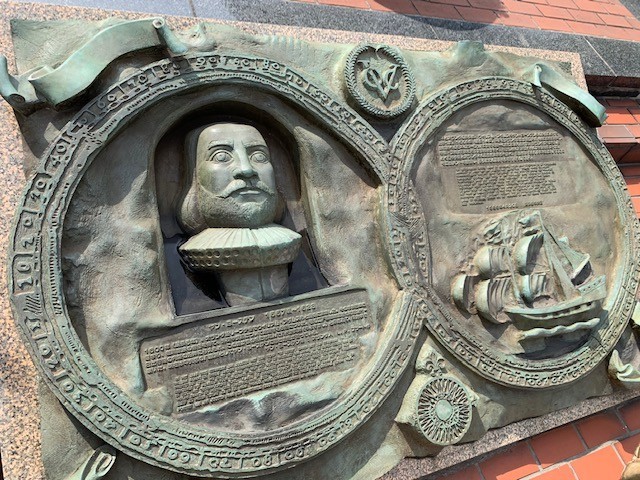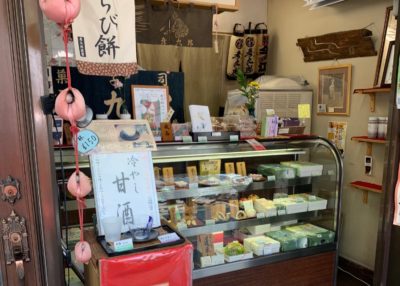Nihonbashi and Ningyocho are two neighboring areas not too far from Tokyo station that tend to be overlooked by tourists in favor of places like Ginza and the Imperial Palace nearby. There are some great reasons to visit these historical hoods on your Japan tour though, especially if you like Tokyo history, shopping, and local food.

Nihonbashi History
In the early 16th century, Tokyo was still called Edo, and the city only just started to develop around the newly-built castle where the Tokugawa shogunate took its seat. Of course, the castle and the important people living nearby needed all kinds of services and products. The Nihonbashi, literally ‘Japan Bridge’ was built in 1603, the year the shogunate was established, and quickly became a heavily used bridge for merchants and other people servicing the castle and surrounding areas.
The bridge was built at a convenient location that was the point where 5 major trade roads terminated, so it only made sense that the area surrounding the bridge would become a lively place with plenty of eateries, watering holes, and entertainment establishments to keep the merchants happy. Some of the department stores that are still there today like Mitsukoshi were founded in those early days, and commercial success never stopped for Nihonbashi.
Nihonbashi Highlights
Many highlights in Nihonbashi are tied to its history and culinary culture. Let’s start with the ‘zero point’, the point to which road signage refers if they show the number of kilometers to Tokyo. This important point can be found on the Nihonbashi bridge and is marked with a metal square. If you want to see what Nihonbashi must have looked like during the Edo period you can get a good idea of that in the Mitsukoshimae subway station, as some of the walls are adorned with drawings that depict life in Nihonbashi during that time.
As Nihonbashi was always surrounded by lots of water, canals are an important part of the area. It was of great use for the fish market that used to be here, which was later relocated to Tsukiji and then to Toyosu. Nowadays, you can take a short cruise in the canals to see this part of the city from a different point of view.
Foodies with a bit of an adventurous palate will love Nihonbashi, the basement of Mitsukoshi is a paradise for lovers of local food. You can get high-end super tasty fruits here, delicious pastries, all kinds of pickles you can think of, many types of tofu, Japanese-style fried dishes, and much more.
Shopping in Nihonbashi
But that is not all, because Nihonbashi is also the area where some prefectures of Japan have their satellite shops, meaning you can get local specialties of other Japanese regions in Nihonbashi without having to travel. The prefectures of Toyama, Nara, Shimane, and Yamanashi all have satellite shops in Nihonbashi.
Some very Japanese cooking ingredients can also be bought at specialty shops in Nihonbashi like bonito flakes, dried seaweed (nori), and a soy sauce specialist. Hobby cooks should definitely stop by here for some edible souvenirs!
For shopping, the Mitsukoshi is a classic that can’t be skipped, even if you would only go there for some window shopping. Mitsukoshi was originally a kimono specialist, and you can still buy beautiful kimono and kimono paraphernalia here. The much newer Coredo is a beautifully designed department store with all kinds of shops, restaurants, and cafes. It is especially recommended to visit Coredo during the cherry blossom period in the evening as they do a beautiful light-up event there. Near Coredo you can also find the Fukutoku shrine, which is where many business people come to pray for financial success.
Ningyocho History

Ningyocho is officially a part of Nihonbashi, and it used to be the heart of the culture of performing arts during the Edo period. Many forms of entertainment could be enjoyed here, ranging from kabuki, storytelling, magicians, juggling to puppeteering. There were also a lot of doll makers who moved to the area, which is where the name ‘Ningyocho’, or ‘Puppet town’, came from. In the mid-19th century, all these entertainers were moved to Asakusa though, because the city government preferred them over there.
Nowadays, you won’t find many remnants relating to dolls anymore in Ningyocho, however, there are still some details in which you can see the neighborhood’s past. First of all, there are two clock towers that ‘perform’ a short puppet show telling the stories of firemen and rakugo storytellers (a type of Japanese comedy). Secondly, you can buy so-called ‘ningyoyaki’ here, a regional edible souvenir made with red beans. You can still feel an atmosphere reminiscent of the old days in Ningyocho because the area didn’t completely burn down in either the earthquake of 1923 or during the bombings of WW2, unlike most of Tokyo.
Ningyocho Highlights
So what should you do in Ningyocho? Besides having a look at the clock towers when they are moving (every hour between 11 am and 7 pm) and tasting freshly baked ningyoyaki, there are some other cultural treasures and local delicacies to discover as well.
The Suitengu shrine’s building is quite new, but the history of the shrine goes back to the early 19th century when a daimyo family founded the shrine in another area and then moved it to its present location a few decades later. Couples wishing for a healthy baby come to this shrine to pray for that to happen, so you will see a lot of expecting couples and not-yet-pregnant couples hoping to conceive. This is also why there is a statue of a female dog on the shrine grounds; a dog has many babies and is seen as a symbol of fertility. By rubbing the dog’s statue, a bit of her fertility should rub off on you as well.
Ningyocho Shopping
Okannon-ji temple is near the Suitengu shrine, and also worth a quick visit. This Buddhist temple is a part of a 33 Kannon temple pilgrimage route and dedicated to the goddess Kannon, the goddess of mercy. People who are going through a difficult time in life often come to pray to Kannon to make their suffering a bit lighter. This is also why you will often find jizo statues at a Kannon temple, which you can also find at Okannon-ji. Jizo statues are there to pray for the souls of children who were lost before or soon after birth.
Now on to a more uplifting place, Amazake Yokocho is nearby and full of little shops selling all kinds of traditional Japanese snacks. The street was named after the product of the shop that used to be situated at the beginning of the street, amazake. This is also why during the New Year’s period they still sell amazake in many shops in this street. The shops you should definitely check out when you are in Amazake Yokocho are Gyokueido for beautifully crafted wagashi, Tsukushi for Edo-style old-fashioned sweets, Soukaya for savory senbei crackers, and Morinoen for all things hojicha (tea). When it comes to Ningyocho, come hungry and leave happy after snacking your way through the neighborhood.
Your Japan Tour
As seasoned Japan experts, we can help you create your perfect Japan tour including the areas in Tokyo where you can still get a feel for its history like Nihonbashi and Ningyocho. Contact us to start planning your unforgettable holiday to this fascinating country full of once-in-a-lifetime experiences, culture, history, nature, and delicious food!